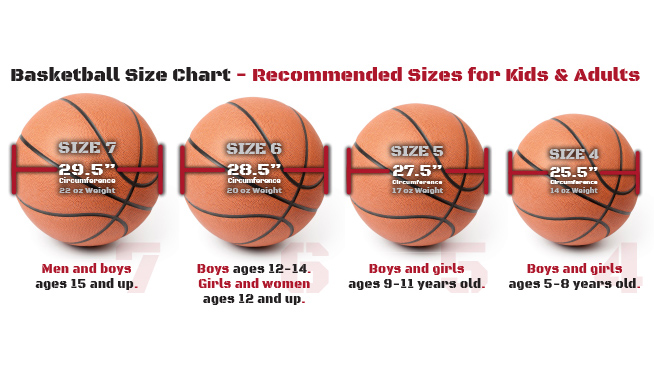Basketball Sizes: A Quick Guide for All Levels of Play
NBA and College Basketball Sizes
Basketball sizes vary by age, gender, and level of play. The official size of the basketball used by the NBA is 29.5 inches in circumference. That’s the same size used throughout men’s college and high school basketball leagues. The WNBA uses a slightly smaller ball, measuring 28.5 inches in circumference.
For international play, specifically FIBA, the basketball used is what’s called a Molten GL7 for men and Molten GL6 for women. These basketballs typically feature two different colors and are slightly bigger, with a 30.7-inch circumference for the men’s ball and a 29-inch circumference for the women’s.
Youth Basketball Sizes
Boys in middle school (or ages 12-14), use a 28.5-inch ball, as do all women and girls ages 12 and up. For anyone, male or female, between the ages of nine and 11, a ball size of 27.5 inches in circumference is recommended and is the most commonly sized ball used in youth basketball leagues.
Boys and girls between the ages of 4 and 8 use a basketball between sizes of 22 inches and 24.5 inches in circumference, depending on the individual’s hand size, which can be determined by a coach or parent by measuring from the bottom of the individual’s palm to the tip of his or her middle finger.
Basketball Inflation and Pressure Regulations
An NBA basketball must be inflated to a pressure of 7.5 to 8.5 PSI. The WNBA uses the same pressure regulations.
In the NCAA, inflation requirements are given in weight, with the men’s ball having a maximum weight of 22 ounces and the women’s ball having a maximum weight of 20 ounces. In FIBA play, the official rules state that the ball “be inflated to an air pressure such that, when it is dropped onto the playing floor from a height of approximately 1,800 mm measured from the bottom of the ball, it will rebound to a height of between 1,200 mm and 1,400 mm, measured to the top of the ball.”

What is the Diameter of a Basketball?
A standard NBA basketball has a diameter between 9.43 and 9.51 inches. In the WNBA, the basketball has a diameter of between 9.07 and 9.23 inches. Basketballs used in the NCAA are between 9.39 and 9.55 inches for men and 9.07 and 9.23 inches for women.
Indoor vs. Outdoor Basketballs (a.k.a. “Street” Basketballs)

Basketballs used for indoor and outdoor play differ in their material. Indoor basketballs are made of full-grain leather; basketballs meant for outdoor use are made of rubber.
Though basketballs made for indoor use may initially feel smooth to the touch, after a few uses, they become somewhat broken in and easier to grip, much like a baseball mitt. Leather basketballs should not be used outside because the concrete surface of an outdoor basketball court causes the leather to roughen and wear, which eventually ruins the ball’s grip.
Some indoor basketballs are made of composite or synthetic leather. The upside is that they don’t need to be broken in like a regular leather ball. But generally speaking, the quality is not as good.
Outdoor, or “street” balls, employ a rubber surface because it can absorb the rougher surface of a concrete court without sacrificing the ball’s grip. A rubber ball is also a good choice for beginners because it is the easiest ball to control.
Best Selling Basketball Brands
The three best-selling basketball brands are Spalding, Nike, and Wilson. As the official ball of the NBA, Spalding is perhaps the most recognized basketball manufacturer. Nike and Wilson are also popular thanks to the variety of textures, technologies, and color schemes they offer.
A typical official-size men’s basketball retails on average between $30 and $60. Both the NBA and WNBA use Spalding basketballs, while the NCAA and most youth leagues use Wilson. As mentioned previously, FIBA and international leagues use Molten as their basketball provider.
READ MORE:
RECOMMENDED FOR YOU
MOST POPULAR
Basketball Sizes: A Quick Guide for All Levels of Play
NBA and College Basketball Sizes
Basketball sizes vary by age, gender, and level of play. The official size of the basketball used by the NBA is 29.5 inches in circumference. That’s the same size used throughout men’s college and high school basketball leagues. The WNBA uses a slightly smaller ball, measuring 28.5 inches in circumference.
For international play, specifically FIBA, the basketball used is what’s called a Molten GL7 for men and Molten GL6 for women. These basketballs typically feature two different colors and are slightly bigger, with a 30.7-inch circumference for the men’s ball and a 29-inch circumference for the women’s.
Youth Basketball Sizes
Boys in middle school (or ages 12-14), use a 28.5-inch ball, as do all women and girls ages 12 and up. For anyone, male or female, between the ages of nine and 11, a ball size of 27.5 inches in circumference is recommended and is the most commonly sized ball used in youth basketball leagues.
Boys and girls between the ages of 4 and 8 use a basketball between sizes of 22 inches and 24.5 inches in circumference, depending on the individual’s hand size, which can be determined by a coach or parent by measuring from the bottom of the individual’s palm to the tip of his or her middle finger.
Basketball Inflation and Pressure Regulations
An NBA basketball must be inflated to a pressure of 7.5 to 8.5 PSI. The WNBA uses the same pressure regulations.
In the NCAA, inflation requirements are given in weight, with the men’s ball having a maximum weight of 22 ounces and the women’s ball having a maximum weight of 20 ounces. In FIBA play, the official rules state that the ball “be inflated to an air pressure such that, when it is dropped onto the playing floor from a height of approximately 1,800 mm measured from the bottom of the ball, it will rebound to a height of between 1,200 mm and 1,400 mm, measured to the top of the ball.”

What is the Diameter of a Basketball?
A standard NBA basketball has a diameter between 9.43 and 9.51 inches. In the WNBA, the basketball has a diameter of between 9.07 and 9.23 inches. Basketballs used in the NCAA are between 9.39 and 9.55 inches for men and 9.07 and 9.23 inches for women.
Indoor vs. Outdoor Basketballs (a.k.a. “Street” Basketballs)

Basketballs used for indoor and outdoor play differ in their material. Indoor basketballs are made of full-grain leather; basketballs meant for outdoor use are made of rubber.
Though basketballs made for indoor use may initially feel smooth to the touch, after a few uses, they become somewhat broken in and easier to grip, much like a baseball mitt. Leather basketballs should not be used outside because the concrete surface of an outdoor basketball court causes the leather to roughen and wear, which eventually ruins the ball’s grip.
Some indoor basketballs are made of composite or synthetic leather. The upside is that they don’t need to be broken in like a regular leather ball. But generally speaking, the quality is not as good.
Outdoor, or “street” balls, employ a rubber surface because it can absorb the rougher surface of a concrete court without sacrificing the ball’s grip. A rubber ball is also a good choice for beginners because it is the easiest ball to control.
Best Selling Basketball Brands
The three best-selling basketball brands are Spalding, Nike, and Wilson. As the official ball of the NBA, Spalding is perhaps the most recognized basketball manufacturer. Nike and Wilson are also popular thanks to the variety of textures, technologies, and color schemes they offer.
A typical official-size men’s basketball retails on average between $30 and $60. Both the NBA and WNBA use Spalding basketballs, while the NCAA and most youth leagues use Wilson. As mentioned previously, FIBA and international leagues use Molten as their basketball provider.
READ MORE:










